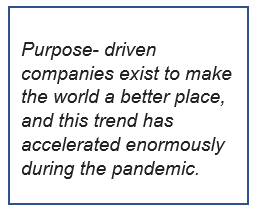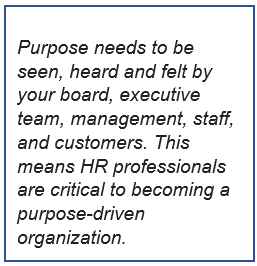
Is Becoming Purpose-Driven an Antidote for The Great Resignation?

Author: Charla Vall, Founder & Principal at Vall Impact Company
The Realities Facing Organizations Today
For a variety of reasons, Canadian employees are leaving their jobs in droves, and there are no signs of this trend slowing down.
28% of Canadians surveyed in a recent Leger poll 1 said they voluntarily left their job in the last two years. 43% said they’re likely to look for a new opportunity in the next 2 years.
What does this mean for organizations, and HR professionals in particular?
In short, you’re desperately fighting to attract, and keep your talent.
But the approaches you have used in the past are unlikely to be effective this time 2 .
Scott Sonenshein, an organizational psychologist and New York Times best-selling author, put it bluntly on Brene Brown’s Dare to Lead podcast :
"If you think you’re going to come in and operate your business as if it’s February 2020, you’re going to get crushed. If you think you’re leading the same workforce – people with the same mindset, the same mentality, the same desires, and the same priorities – you are nuts. You have to change or get out of the way. There’s no turning back”
That’s a hard dose of reality to swallow.
But there’s another trend that has picked up steam during the pandemic.
This trend might even represent the change you need to wake up your disengaged employees before they walk.
Welcome to The New Era of Business
Let me take a guess… you’ve heard of the brands Patagonia, Tom’s Shoes and Seventh Generation.
Is it because their products are especially good? No. Although that does help.
These companies stand out from the crowd because they do things differently.
More specifically, they are guided by a purpose that extends well-beyond generating profits.
They exist to make the world a better place, in some form or another.

And in recent years, more and more brands are adopting a purpose. This trend has accelerated enormously since the Covid-19 pandemic 3 .
Mainstream companies like Unilever, HP, Canva, AirBnb, Maple Leaf Foods, Telus, among many others, have declared a purpose that aims to benefit society 4 .
It guides the company in everything they do.
What Does Purpose Have to Do with The Great Resignation?
It turns out that adopting a purpose, and becoming a truly purpose-driven company, makes you much more likely to attract and retain top talent
5
.
Millennials are more than 5 times more likely to stay when they have a strong connection to their employer’s purpose 6
.
A survey conducted in Summer 2020 found that nearly 9-in-10 employees say working for a company with a strong purpose is more important to them now than ever before 7
.
Becoming purpose-driven may be the kind of shake-up that won’t just make your staff want to stick around, but will turn them into champions for your organization.
Purpose is Not a Tactic, It Requires a Strategy
There’s a catch though, declaring your company has a purpose is not enough.
Purpose needs to be embedded into the core fabric of your organization 8 .
It needs to be seen, heard and felt by your board, executive team, management, staff and customers.
In other words, purpose can’t just be written on the wall.
To be authentically purpose-driven, your purpose can only be activated by people.
This means HR professionals are critical players in promoting a purpose-driven culture throughout their organization.

How Do You Become a Purpose-Driven Organization?
You might be intrigued, or even convinced, by the idea that purpose is a promising pathway to addressing so many of the challenges facing your company with respect to staff attraction and retention.
But what can you do if your company is not actively purpose-driven?
And once your company adopts a purpose, what can HR professionals do to embed it throughout their organization?
I’m thrilled to be answering these very questions in my upcoming workshop for CPHR.
Learn more about the new era of the Purpose-driven business and the role of HR Professionals at the HR Bootcamp on May 19 th .
Charla Vall is the founder & Principal at Vall Impact Company. Throughout her career, Charla has focused on addressing the root causes of society’s complex problems. Now, as an independent consultant, Charla helps impact-driven organizations gain the clarity, confidence and capacity to execute bold strategies that create real social and environmental change.
References
- The Human Reality: Rethinking HR During the Great Resignation. Leger, May 4, 2022. https://leger360.com/surveys/the-human-reality-rethinking-hr-during-the-great-resignation/
- The Human Reality: Rethinking HR During the Great Resignation. Leger, May 4, 2022. https://leger360.com/surveys/the-human-reality-rethinking-hr-during-the-great-resignation/
- Fulwood, Alice. “ What’s behind the exploding number of shareholder resolutions on corporate purpose?” Money Talks, Spotify app., May 4, 2022. https://www.economist.com/podcasts/2022/05/04/whats-behind-the-exploding-number-of-shareholder-resolutions-on-corporate-purpose
- StrawberryFrog and RepTrak. “Purpose Power Summit: How the Pandemic Changed Brand Purpose as We Know It”. Inc., June 2021. https://www.purposepowerindex.com/purpose-power-index-study-2021
- Bumb, Nikhil and Smith, Dane. “Companies that Lead With Authentic, Ambitious Purpose Can Capture Value From Six Sources”. Shared Value Initiative, July 24, 2019. https://www.sharedvalue.org/companies-that-lead-with-authentic-ambitious-purpose-can-capture-value-from-six-sources/
- “Putting Purpose to Work: A study of purpose in the workplace”. PwC, June 2016. https://www.pwc.com/us/en/about-us/corporate-responsibility/assets/pwc-putting-purpose-to-work-purpose-survey-report.pdf
- “PN Purpose Tracker: Employee Perspectives on Responsible Leadership During a Crisis”. Porter Novelli, August 2020. https://www.porternovelli.com/wp-content/uploads/2021/01/02_Porter-Novelli-Tracker-Wave-X-Employee-Perspectives-on-Responsible-Leadership-During-Crisis.pdf
- “Putting Purpose to Work: A study of purpose in the workplace”. PwC, June 2016. https://www.pwc.com/us/en/about-us/corporate-responsibility/assets/pwc-putting-purpose-to-work-purpose-survey-report.pdf
The views and opinions expressed in this blog post belong solely to the original author(s) and do not necessarily represent the views and opinions of CPHR Alberta.
The views and opinions expressed in this blog post belong solely to the original author(s) and do not necessarily represent the views and opinions of CPHR Alberta.





